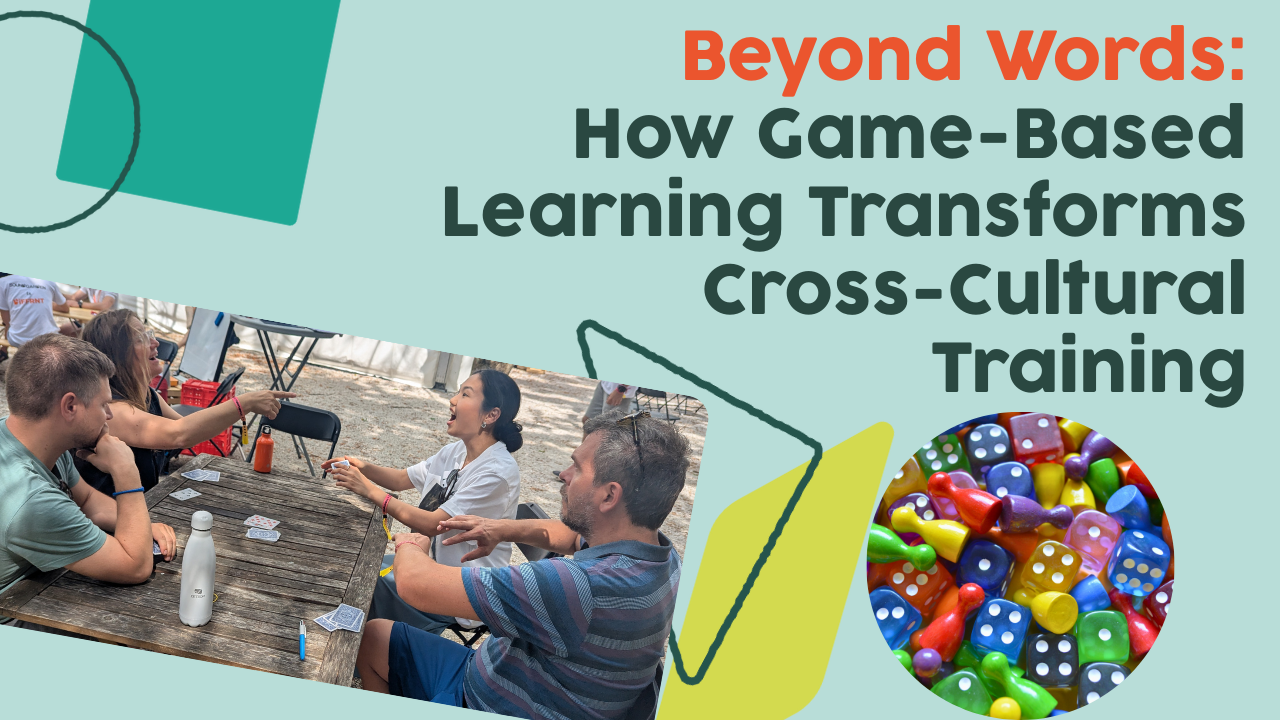
The Challenge of Real Cross-Cultural Learning
In our interconnected world, cultural awareness is no longer a “nice to have.” Whether leading global teams, coaching diverse groups, or designing inclusive strategies, understanding cultural nuances is crucial.
Yet traditional cross-cultural training often stays at the surface – delivering knowledge about cultures without creating real behavioural or mindset shifts.
From my own experience conducting needs analyses before cross-cultural workshops, I’ve seen this pattern repeatedly: participants want a list of dos and don’ts. They want certainty. They ask, “Just tell me how I should behave to avoid mistakes.”
But here’s the truth: there are no universal rules that guarantee certainty in intercultural encounters. What we actually need is ambiguity tolerance – the ability to remain effective and open when situations are unclear or expectations conflict.
And that is precisely where game-based learning comes in.
Game-Based Learning (GBL): Moving from Theory to Experience
Research shows that game-based simulation offers this transformative potential. As Madni (2012) explains, combining classical game theory, behavioural game theory, and multi-agent simulations in cross-cultural decision-making training makes learning enjoyable, memorable, and effective.
Why? Because people learn best by doing, especially when dealing with soft skills like intercultural collaboration, negotiation, and decision-making under diverse perspectives.
From Knowledge to Deep Awareness
Arnab et al. (2010) highlight four dimensions of effective GBL for cross-cultural awareness:
- Context Adaptation
Games must address verbal and non-verbal communication, socio-behavioural habits, and real-world cultural contexts. For example, the e-VITA project used seniors’ stories to teach intergenerational European cultural understanding. - Learner-Centric Design
Personalised learning journeys that adapt to each learner’s cultural background ensure relevance and engagement. - Representation that Combats Stereotypes
GBL provokes emotion, interest, and reflection, fostering both empathy and respect for one’s own and others’ values. - Diverse Pedagogical Approaches
Combining narrative immersion, experiential learning, and exploratory tasks makes cultural learning dynamic and meaningful.
Stories That Stay With You
I’ll never forget an evening with a friend from Azerbaijan. We were laughing about gestures – how a simple Italian sign for “I’m hungry” or “This food is delicious” could be perceived as an insult in Azerbaijan. We had so much fun realising how the same movement can communicate affection in one culture and offence in another.
Or the time I spoke with a German politician at the European Parliament. He was listening to an Italian colleague speak, headphones on, waiting for the simultaneous translation. Nothing came through. Looking puzzled, he turned to his neighbour and asked:
“What’s happening? Why don’t I get any translation?”
His neighbour, who spoke Italian, smiled and said:
“Don’t worry – he hasn’t actually said anything substantial yet. Just some opening waffle.”
It made me smile because it reflected so clearly how different cultures structure communication. What might feel like necessary context-building or relationship-building in one culture can feel like unnecessary fluff in another.
Of course, we don’t want to generalise. Not every Italian politician starts with long introductions, nor do all Germans get straight to the point. But these moments remind us: it’s not just what is said, but how it is perceived that shapes our understanding.
What Makes Game-Based Cross-Cultural Training Different?
✔️ Safe Environment – Learners test approaches and reactions without real-life risks
✔️ Emotional Engagement – Stories and choices evoke feelings that anchor insights
✔️ Behavioural Change – Moves beyond theory into applied skills and flexible strategies
✔️ Joyful Learning – Fun and challenge motivate deeper involvement
My Perspective as a Creative Catalyst
Having facilitated cross-cultural trainings for decades, I’ve seen how games unlock perspectives that lectures never reach. They open a playful yet powerful space where curiosity replaces judgement – where people realise how their own cultural imprinting shapes decisions and interactions.
In my experience, GBL is the most effective way for participants to experience first-hand their own cultural patterns. This is why cultural sensitisation is always the first step in building true cross-cultural competence.
For example, the Personal Inner Team (PIT) is a powerful starting point. When participants discover the diversity of resources and approaches within themselves, it becomes easier to appreciate and bridge differences with others.
Where Next?
Game-Based Learning isn’t just for schools or technical training. It is a powerful tool for:
• 🌎 Cross-cultural coaching sessions
• 👥 Team-building across generations and cultures
• 💡 Leadership development that goes beyond cognitive understanding to real-life competence
💭 Curious how Game-Based Learning could transform your next cross-cultural training or leadership retreat?
I design immersive, research-backed, and deeply human-centred experiences that build bridges instead of barriers.
👉 Reach out to explore what’s possible for your team or organisation.
References
- Madni, A.M. (2012). Game-Based Simulation for Cross-Cultural Decision Making Training. DOI: [link].
- Arnab, S. et al. (2010). Promoting Cross-Cultural Awareness through Exposure in Game-based Learning. IEEE Learning Technology Newsletter, 12(1), 40-43.
